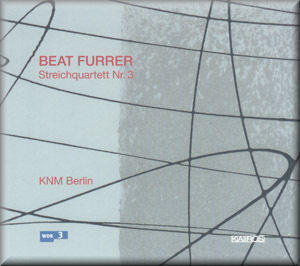 |
 |
|


alternatively
CD: AmazonUK
AmazonUS
|
Beat FURRER (b.1954)
String Quartet No.3 (2004) [51:22]
 KNM Berlin (Steffan Tast (violin), Angela Jaffé (violin), Kirstin Maria Pientka (viola), Ringela Riemke (cello)) KNM Berlin (Steffan Tast (violin), Angela Jaffé (violin), Kirstin Maria Pientka (viola), Ringela Riemke (cello))
rec. Klaus-von-Bismarck-Saal, Cologne 21-24 June 2007. Stereo. DDD.
 KAIROS 0013132KAI [51:22] KAIROS 0013132KAI [51:22] 
|
|
|
Comparing Austrian composers of today with their 18th century compatriots is a bit like comparing contemporary Greek culture with that of ancient times: you can find the respective cultures wanting, but it doesn’t really tell you anything about what is currently happening in either country. In the main, this is because the artists and intellectuals who make up these cultures have found ways of getting over the weight of historical precedent, leaving external commentators to flounder with their stereotypes.
The fact that Beat Furrer writes numbered string quartets suggests a certain relationship with tradition, and indeed there are precedents from the Second Viennese School for much of musical thinking in this work, but on the whole, he is his own man. It is not strictly accurate to describe him as Austrian anyway; he is originally from Switzerland but has lived in Austria for many years and is now a pillar of its musical establishment.
The Third String Quartet was commissioned by WDR for a premiere by the Arditti Quartet, and you can really imagine the Ardittis getting their teeth into it. The musical discourse takes a broad vocabulary of extended techniques as the basis for its musical language, and any ensemble coming to it must be able to put in the artificial harmonics, double stopped arpeggios, fluttering bow effects etc. as if they were second nature. The KNM Berlin players do exactly that, and it is hard to imagine a more vibrant or detailed account, even from the Ardittis themselves. Excellent sound quality too; much of the music is very quiet, but nothing is lost to the precision audio. The stereo array sets the instruments quite far apart, an excellent idea given the independence of the individual lines, which are all the better articulated for the separation of the channels.
The work is certainly in an advanced idiom, but it never grates. Most of the textures involve only one or two players, performing at low dynamics. The fabric of the work is made up of short musical ideas, often repeated but with each iteration clearly distinct. Textures are built up through the overlapping of these cells, but never at the expense of the clarity of line. The form is intriguing. The work is in a single 50 minute movement, based, according to the composer on ‘reverse narrative’ and ‘overlapping montage’. Although I couldn’t tell you exactly how ‘reverse narrative’ works in this context, it is felt through the way that the music has a sense of direction and purpose, but these are always conditional and mediated. The idea that things may be happening in reverse is apparent from the fact that there is always a sense of logical progression, but the logic itself is very hard to pin down.
A surprise addition comes about half way through in the form of a Protestant chorale theme based on the 22nd Psalm. Again, issues of musical tradition immediately come to mind, with Brahms 4 and Berg’s Violin Concerto providing Austrian precedents. But Furrer, to his immense credit, is not relying on the chorale for redemption, or even conclusion. It never appears in an unadulterated form, rather it gradually begins to inform the particulate textures, without forcing them to cohere. Its message and purpose remain definite but deeply ambiguous.
What then, in lieu of redemption? Well, the music begins with isolated cells – textural rather than thematic ideas – and in the end it dissolves again into a similarly fragmented realm. But then, all of the intervening music has basically been like this, just with the textures a little more overlapped. It is quite an achievement to create 50 minutes of music from such slender means. But he does, and the results are always engaging, always musical, and most impressively of all, radical without ever resorting to aggression.
Gavin Dixon
Always engaging, always musical …radical without ever resorting to aggression.… see Full Review
|
|

